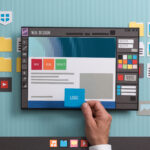A High-Level Guide to Enterprise UX : Insights & ideas for legacy system redesign

What is Enterprise UX?
Meaning of Enterprise Design:
If you have ever used applications like MS Excel, Tableau, Jira, Salesforce or MS Teams, you have interacted with enterprise products. In fact, a majority of employees in any organization today spend about 20-40 hours a week on enterprise platforms and products.
These are no-nonsense, serious and power users of the software, unlike retail-based consumer software, which usually provide specific services to the users that may or may not be used regularly. Usually, these products encompass internal tools and functions like human resource management, customer relationship management, accounting and project planning.

The design of enterprise applications is a very wide and diverse use-case field. This article is meant to be a high-level guide to what enterprise UX or EUX is. It provides direction on how to move when choosing the right software for your employees or even to push the idea of why UX is necessary in such large applications, to your management.
Major Challenges in Enterprise UX design
The biggest difference between a consumer application and an enterprise application is the varying levels of complexity each contains. This is also the most significant challenge when it comes to defining a good UX for enterprise applications or redesigning existing ones for better UX. Consumers make conscious choices and interact with applications suitable to their needs and have high expectations which they hope will be satisfied.
The actual users of enterprise applications are hardly the ones calling the shots on which software to acquire and from where. It is a higher level management team that makes these decisions, which may or may not put the users’ needs first, since their job is to satisfy business priorities. They hardly have any expectations from the application and expect it to just fit right into their work process and complete some tasks they have to perform repeatedly and often.

Another challenge is the high costs involved in transitioning to new software – whether it is replacing the old ones or undergoing an enterprise redesign. Why would a company pour money into buying new software when the old one works just fine? Simply put – for higher performance. Enterprise redesign may also include a service redesign, where the entire ecosystem may need refurbishing to deliver quality service more sustainably. Service design and product design together make up enterprise design. Of course, you can sense costs soaring already.
There are several other challenges. As stated earlier, the person buying the product may not even be the end-user, which makes it difficult for designers to empathize with them and tailor-make experiences. No single user will take the same route as the other – which means that they will all have non-linear workflows. Employees in a company usually align their applications according to personal comfort and style of working, thereby avoiding a dent to their output. It is very complicated to design such an application where you do not force any users into a particular user flow and let them accomplish their goals regardless of what path they take to do it.
Solution By Design for Enterprise UX
Designers must aim to make products and experiences that need little hand-holding and tutoring. Ensuring that users can complete their tasks in the first use and get time to fiddle with the product goes a long way in successfully onboarding them onto a new software.

Although, we must take care not to reinvent the wheel – our target consumers are habitual of certain software patterns and familiar interfaces. Keeping products on the same lines and yet boosting yield can be the biggest unique selling point for EUX. Since the purpose of these applications is to drive the highest performance in the shortest span of time, and we want users to know their way around the logic of the product for long-term use, there is little scope for innovation.
Design Thinking in Enterprise experience design (Enterprise UX)
Legacy systems might be a comfort zone for employees in a company, but they impede the huge growth potential that digital transformation brings with it. Employees are usually happy with the legacy version of software (outdated versions but still in use) because “it works”. Their mindset – if it isn’t broken, don’t fix it. Teams are becoming highly cross-functional and co-dependent. In such a working atmosphere, adoption of new technologies with design thinking provides suitable methods to achieve organizational goals.

EUX is usually complicated and takes time to be adopted. We must not forget to empathize with users. Even in this case – ask relevant and important questions to get to know the user. Organizations and product teams that conduct user research, create and validate proper user personas, and test assumptions before adopting a particular design path can vouch for implementation of design thinking as a cultural fit. This cultural shift needs to occur before design thinking can be implemented to transform companies into delivering true value.
Implementation of Enterprise UX design thinking methodology
What are the principles of enterprise design?
All stakeholders should be involved in the process of adopting EUX, and a proper UX workflow should be established. This means involving visual designers, UX designers (UI/UX designers in some firms), all other design designations like interaction designers and product designers, developers, business analysts, product managers and higher level management as well. This provides for a transparent discussion between those who take decisions and those who are affected by the decisions.
A crucial tip is to modularize the entire project.
Remember that micro-tasks are key to the success of enterprise UX. Your user may enter the product or a workflow from various points and not stick to the one you have decided on due to varying work styles discussed earlier. Breaking down a product into such micro tasks and designing for event success is helpful from a design standpoint. Use simplified navigation elements – global navigation with elements grouped into folders and nested options is the way to go here.

But here’s an important point – usually, designers aim to reduce clutter and have a minimalist UI. Using the same strategy in enterprise applications may get rid of the important functionalities that users need on the screen. It is okay to have a certain level of complexity through which the users learn. We want them to think and take steps, but be able to get habitual eventually.
Prepare a good structure of the product and maintain consistency overall. Providing a home page which acts as a dock for all main actions can aid the user in understanding where exactly they are in the application.
NetBramha’s Top Enterprise UX Projects and Impact We Created
When we say our designs have touched over a billion users and created a global impact, we mean it. We have transformed several industries like real estate and transportation and redesigned user experience for IT products in the entertainment industry.
One of India’s largest ISP – ACT has benefitted from our redesign of each and every application that their staff uses to boost productivity and performance. With ground-up research and feedback with every iteration, we were able to reimagine their service design and give it a whole new shape.
Addverb, a warehouse automation firm, needed a seamless experience. They wanted to capitalize on the existing mental models of users, let them answer a few questions and provide customized solutions. This was a particular crucial project for us as we helped Addverb establish themselves as global thought leaders and increased lead generation.

We were also asked to design a solution for the tech giant Infosys that encouraged decision makers to read their report and partner with Infosys. We used a very distinct visual storytelling approach in the project and were able to meet higher user outreach.
These are just some examples of the impact we have created through integrating UX in enterprise application design.
Not everyone understands how design thinking can fit in their workflow and yes, it is not a task to be done overnight. There is a need to educate companies about optimizing design according to the problem at hand and aiming for digital growth, as to how it can benefit them in making a dash for global dominance. There are hundreds and thousands of factors to consider and several issues too. Nevertheless, disruption lies in thinking out-of-the-box, and your organization may just be one better enterprise application away from gaining the momentum you want it to.


